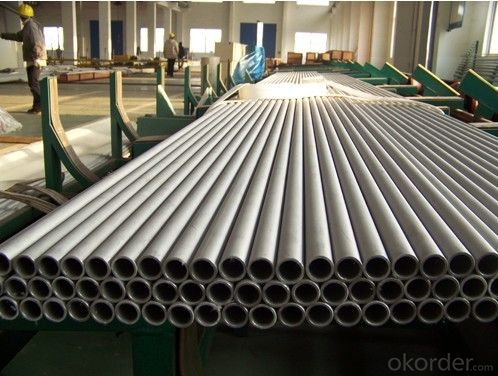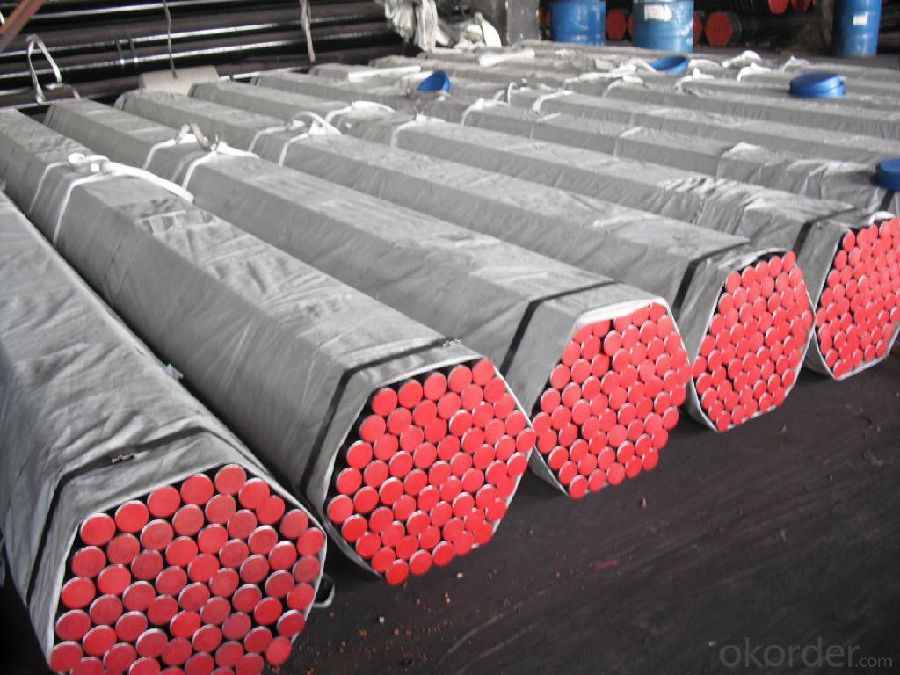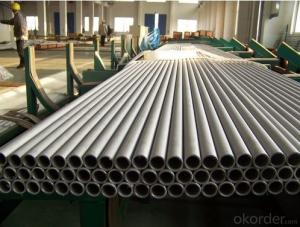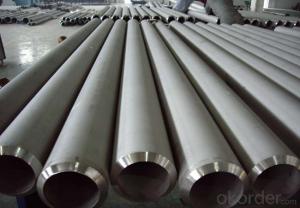Austenitic Seamless Steel Pipe Good Corrosion Resistance 304(0Cr18Ni9)
- Loading Port:
- Ningbo
- Payment Terms:
- TT OR LC
- Min Order Qty:
- 1 m.t.
- Supply Capability:
- 5000 m.t./month
OKorder Service Pledge
OKorder Financial Service
You Might Also Like
1、Structure of seamless steel pipe 304 Description:
A large amount of Seamless Steel Pipes 304 are offered to the clients at cost effective rates. These pipes are extremely durable, resistant to corrosion and have high tensile strength. Our pipes are used in nuclear plants, power plants, refineries and construction industry across the country. Furthermore, we are capable of providing these seamless pipes to the clients in bulk quantity.
2、Main Features of the seamless steel pipe 304:
• High manufacturing accuracy
• High strength
• Small inertia resistance
• Strong heat dissipation ability
• Good visual effect
•Reasonable price
3、seamless steel pipe 304 images:



4、seamless steel pipe 304 Specification:
1.Type:seamless
2.Standard:ASTM
3.Material Grand:304 stainless steel
4.Size:OD8-1000MM*WT0.5-80MM
Standard: | JIS, AISI, ASTM, GB, DIN, EN | Place of Origin: | Zhejiang China (Mainland) | Brand Name: | SR |
Type: | Seamless | Steel Grade: | 300 Series | Certification: | ISO |
Thickness: | 0.8mm--22mm | Outer Diameter: | 20mm--800mm | process: | Cold drawn,cold roll |
product: | seamless pipe/tube,elbow,tee,reducer | MOQ: | 1000kg | standard: | A312/A213/A269/A249/A358/A268/A789/ |
Packaging & Delivery
Packaging Detail: | Standard seaworthy package(wooden boxes package,pvc package, and other package) |
Delivery Detail: | 5-30 days after confirmation of prepayment depending on quantity |
Tolerance | a) Outer Diameter: +/- 0.2mm b) Thickness: +/- 0.02mm c) Length: +/- 5mm |
Surface | 180G, 320G, 400G Satin / Hairline 400G, 500G, 600G or 800G Mirror finish and so on. |
Specification | ASTM A213,ASTM A312,ASTM A269,ASTM A778,ASTM A790,DIN 17456,DIN 17458,JIS G3459,JIS G3463 etc |
Material | TP304,TP304L,TP304H,TP304/304L,TP316,TP316L,TP316/316L,TP310,TP317, TP317L,TP321,TP321H,TP347,TP347H,S31803,S32205(Duplex),904L etc |
Application range | Stainless steel pipe applies to construction field, ships building industry, petroleum & chemicalindustries, war and electricity industries,food processing and medical industry, boiler heat exchanger,machinery andhardware fields. Stainless steel pipe can be made accordingto the customers requirements. |
Delivery conditions | Annealed, pickled & polished. |
Note | We can produce other standard as the customers’ requirement. |
5、FAQ of seamless steel pipe 304:
①How is the quality of your products?
Our products are manufactured strictly according to national and internaional standard, and we take a test
on every pipe before delivered out. If you want see our quality certifications and all kinds of testing report, please just ask us for it.
Guaranteed: If products’ quality don’t accord to discription as we give or the promise before you place order, we promise 100% refund.
②How about price?
Yes, we are factory and be able to give you lowest price below market one, and we have a policy that “ for saving time and absolutely honest business attitude, we quote as lowest as possible for any customer, and discount can be given according to quantity”,if you like bargain and factory price is not low enough as you think, just don’t waste your time.Please trust the quotation we would give you, it is professional one.
③Why should you chose us?
Chose happens because of quality, then price, We can give you both.Additionally, we can also offer professional products inquiry, products knowledge train(for agents), smooth goods delivery, exellent customer solution proposals.Our service formula: good quality+good price+good service=customer’s trust
SGS test is available, customer inspection before shipping is welcome, third party inspection is no problem.
Any question, pls feel free to contact us !
- Q:Can stainless steel pipes be pickled and passivated?
- Yes, stainless steel pipes can be pickled and passivated. Pickling is a process that removes impurities and scale from the surface of stainless steel, while passivation is a treatment that forms a protective oxide layer on the surface to enhance corrosion resistance. This process is commonly used in industries such as oil and gas, chemical, and food processing to ensure the cleanliness and longevity of stainless steel pipes. Pickling and passivation can be done using a variety of acidic solutions and techniques, depending on the specific requirements of the pipes and the desired outcome.
- Q:Can stainless steel pipes be anodized?
- No, stainless steel pipes cannot be anodized. Anodizing is a process that is typically used on aluminum to create a protective oxide layer on its surface. Stainless steel already has a natural oxide layer, known as a passive layer, which forms spontaneously when exposed to oxygen. This passive layer provides corrosion resistance to stainless steel pipes and does not require anodizing. Therefore, anodizing is not necessary or feasible for stainless steel pipes.
- Q:SA-179 what kind of material is steel pipe?
- Seamless steel pipe having a hollow cross section, used as a conduit for conveying fluids, such as pipelines for transporting petroleum, natural gas, gas, water, and certain solid materials.
- Q:What is the difference between Schedule 5 and Schedule 10 stainless steel pipes?
- Schedule 5 and Schedule 10 stainless steel pipes find frequent use across various industries and applications, though they possess distinct dissimilarities. The primary disparity resides within their wall thickness. While Schedule 5 stainless steel pipes boast a slimmer wall thickness, Schedule 10 stainless steel pipes possess a thicker wall. Consequently, Schedule 5 pipes exhibit a greater internal diameter, facilitating a more substantial flow of fluids or gases through the conduit. On the contrary, Schedule 10 stainless steel pipes exhibit a reduced internal diameter due to their thicker walls. This renders them more suitable for applications necessitating higher pressure or strength, as the heightened wall thickness grants augmented durability and resistance against external forces. Moreover, the disparate wall thicknesses of Schedule 5 and Schedule 10 pipes influence their weight and cost. Owing to their thinner walls, Schedule 5 pipes weigh less and command a lower price than Schedule 10 pipes. Concerning availability, Schedule 10 stainless steel pipes witness more frequent usage in industrial processes involving high pressure or corrosive environments, such as chemical plants or oil refineries. Conversely, Schedule 5 stainless steel pipes are often employed in applications where the flow of fluids or gases does not encounter extreme pressure, such as plumbing or low-pressure conveying systems. In summary, the principal distinctions between Schedule 5 and Schedule 10 stainless steel pipes lie within their wall thickness, internal diameter, strength, weight, and cost. The choice between the two hinges upon the specific requirements of the application and the level of pressure or durability required.
- Q:How do you calculate the weight of a stainless steel pipe?
- In order to determine the weight of a stainless steel pipe, it is necessary to have knowledge of its dimensions and the density of stainless steel. To begin with, the outer diameter (OD) and wall thickness (WT) of the pipe should be measured. To obtain precise measurements, employ a caliper or ruler. Following that, the inner diameter (ID) can be calculated by subtracting twice the wall thickness from the outer diameter. The formula for determining the ID is: ID = OD - 2 * WT. Subsequently, employ the formula A = π * ((OD/2)^2 - (ID/2)^2), where π is approximately 3.14159, to calculate the cross-sectional area (A) of the pipe. Next, locate the density of stainless steel. While the density may slightly differ depending on the specific grade of stainless steel, the average value is approximately 7.9 grams per cubic centimeter (g/cm³) or 7900 kilograms per cubic meter (kg/m³). Lastly, multiply the cross-sectional area (A) by the length of the pipe (L) and the density (D) to determine the weight. The formula for calculating the weight (W) is: W = A * L * D. Ensure that consistent units are used throughout the calculations. For instance, if the length is measured in meters, the weight will be expressed in kilograms. If the length is measured in inches, the weight will be expressed in pounds.
- Q:Can stainless steel pipes be surface treated?
- Stainless steel pipes have the capability to undergo surface treatment, which is commonly performed to enhance their aesthetics, corrosion resistance, and durability. Surface treatment methods for stainless steel pipes include passivation, electropolishing, pickling, and the application of various coatings. Passivation involves eliminating impurities from the stainless steel's surface, resulting in the formation of a protective oxide layer that improves corrosion resistance. Electropolishing is an electrochemical process that smoothens and polishes the surface of stainless steel pipes, giving them a better appearance and reducing the chances of bacterial growth. Pickling, on the other hand, utilizes acid solutions to remove scale and oxide layers from the surface. Additionally, stainless steel pipes can be coated with substances like powder coating, paint, or plating to offer added protection against corrosion, enhance appearance, or fulfill specific requirements. In conclusion, the options for surface treatment of stainless steel pipes are extensive, allowing for customization to meet functional and aesthetic preferences.
- Q:304 stainless steel seamless tube weight how to calculate?
- 304 stainless steel is a common stainless steel material, the density of 7.93 g/cm3, the industry is also called 18/8 stainless steel. High temperature resistance of 800 degrees, with good processability, high toughness characteristics, widely used in industry and furniture decoration industry and food and medical industry.
- Q:What is the difference between seamless and seamless redrawn stainless steel pipes?
- Seamless stainless steel pipes and seamless redrawn stainless steel pipes are both types of pipes made from stainless steel, but they differ in their manufacturing processes and properties. Seamless stainless steel pipes are produced by piercing a solid billet of stainless steel and then rolling it into a seamless tube using various methods, such as hot rolling, cold rolling, or extrusion. This process does not involve any welding or joining of separate pieces, resulting in a continuous, seamless pipe. Seamless pipes are known for their superior strength, durability, and resistance to corrosion. On the other hand, seamless redrawn stainless steel pipes are manufactured by taking a seamless pipe and subjecting it to a secondary process called cold drawing or cold rolling. In this process, the pipe is pulled through a die or a series of dies to reduce its diameter and improve its surface finish. This cold drawing process enhances the dimensional accuracy, surface finish, and mechanical properties of the pipe. The main difference between seamless and seamless redrawn stainless steel pipes lies in their manufacturing processes and resulting properties. Seamless pipes are generally considered to have higher strength and corrosion resistance than redrawn pipes due to their uninterrupted grain structure and absence of welds. They are commonly used in applications that require high pressure, temperature, or corrosive resistance, such as oil and gas pipelines, chemical processing plants, and power generation facilities. Seamless redrawn stainless steel pipes, although slightly inferior in strength and corrosion resistance compared to seamless pipes, offer improved dimensional accuracy, surface finish, and tight tolerances. They are often used in industries like automotive, aerospace, and pharmaceuticals, where precise dimensions and excellent surface quality are critical. In summary, while both seamless and seamless redrawn stainless steel pipes are made from stainless steel and offer various advantages, the choice between them depends on the specific requirements of the application, such as the level of strength, corrosion resistance, dimensional accuracy, and surface finish needed.
- Q:What is the maximum temperature that stainless steel pipes can handle?
- The specific grade of stainless steel being used determines the maximum temperature that stainless steel pipes can withstand. Stainless steel pipes are generally recognized for their ability to resist high temperatures, making them suitable for various applications in industries like petrochemical, oil and gas, and power generation. The most commonly used grades of stainless steel in pipes, such as 304 and 316, have a maximum operating temperature of approximately 870°C (1600°F). These grades possess exceptional corrosion resistance and can endure high temperatures, making them appropriate for a wide range of industrial processes. Nevertheless, there are certain specialized stainless steel grades, like 310 and 321, which can handle even higher temperatures. These grades contain higher levels of chromium and nickel, offering enhanced resistance to oxidation and scaling at temperatures up to 1150°C (2100°F). It is important to consider that the maximum temperature stainless steel pipes can handle is also influenced by other factors, such as the duration of exposure, the presence of corrosive environments, and the specific requirements of the application. Therefore, it is always advisable to consult with a materials engineer or manufacturer to determine the appropriate grade and maximum temperature limits for a particular stainless steel pipe application.
- Q:What is the difference between schedule 40 and schedule 80 stainless steel pipes?
- Schedule 40 and schedule 80 refer to the wall thickness of stainless steel pipes. The main difference between schedule 40 and schedule 80 stainless steel pipes is the pressure rating. Schedule 40 pipes have a lower pressure rating and are typically used for low to medium pressure applications, while schedule 80 pipes have a higher pressure rating and are suitable for high-pressure applications. The thicker wall of schedule 80 pipes allows them to handle higher pressure, making them a better choice for applications where the pipe needs to withstand more stress or carry fluids or gases at higher pressures. Schedule 80 pipes are commonly used in industrial settings, such as oil refineries, chemical plants, and power plants, where high pressure or corrosive environments are present. On the other hand, schedule 40 pipes are more commonly used in residential and commercial applications, such as plumbing systems, water supply lines, and HVAC systems, where lower pressure requirements are typically encountered. It is important to consider the specific requirements of the project and consult with a professional to determine the appropriate schedule of stainless steel pipe to ensure safe and efficient operation.
1. Manufacturer Overview |
|
|---|---|
| Location | |
| Year Established | |
| Annual Output Value | |
| Main Markets | |
| Company Certifications | |
2. Manufacturer Certificates |
|
|---|---|
| a) Certification Name | |
| Range | |
| Reference | |
| Validity Period | |
3. Manufacturer Capability |
|
|---|---|
| a)Trade Capacity | |
| Nearest Port | |
| Export Percentage | |
| No.of Employees in Trade Department | |
| Language Spoken: | |
| b)Factory Information | |
| Factory Size: | |
| No. of Production Lines | |
| Contract Manufacturing | |
| Product Price Range | |
Send your message to us
Austenitic Seamless Steel Pipe Good Corrosion Resistance 304(0Cr18Ni9)
- Loading Port:
- Ningbo
- Payment Terms:
- TT OR LC
- Min Order Qty:
- 1 m.t.
- Supply Capability:
- 5000 m.t./month
OKorder Service Pledge
OKorder Financial Service
Similar products
New products
Hot products
Related keywords





























